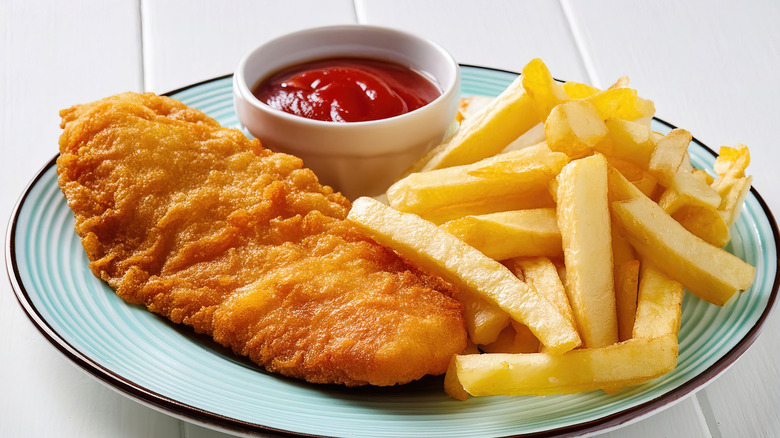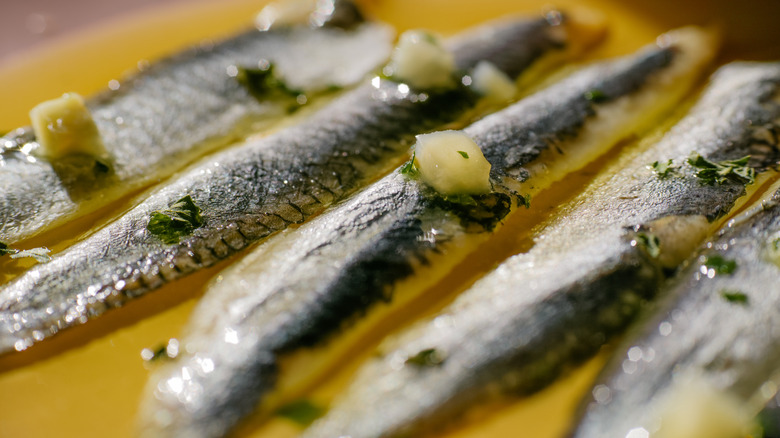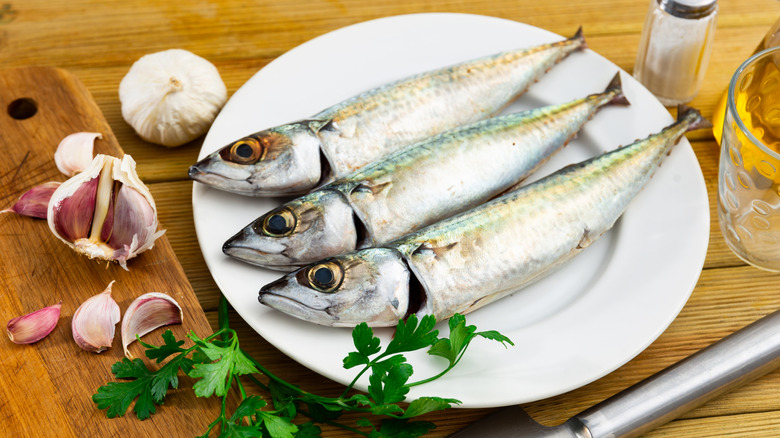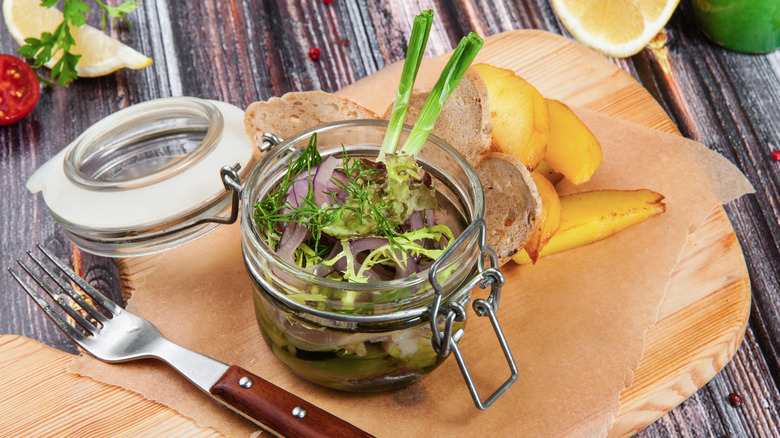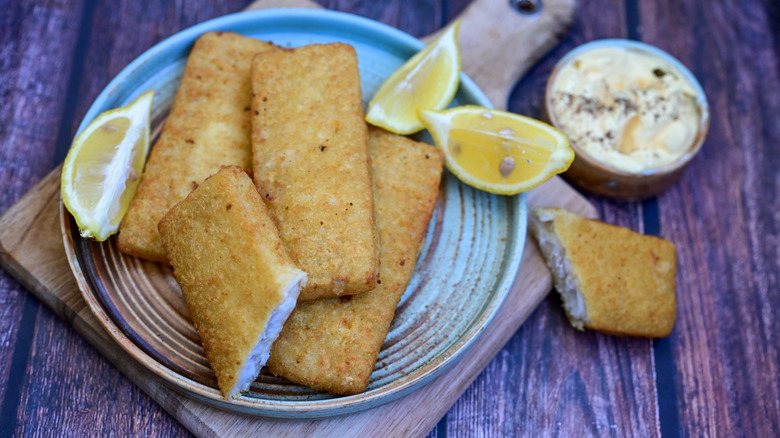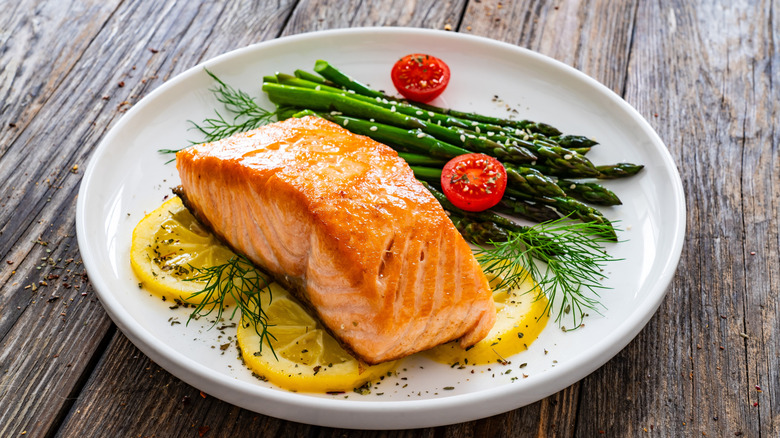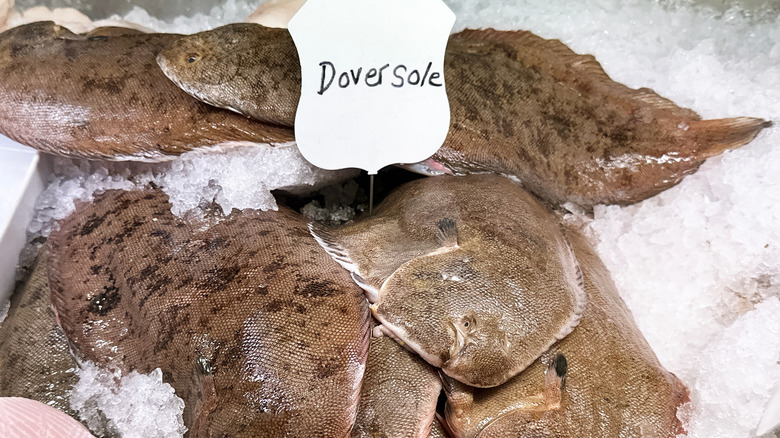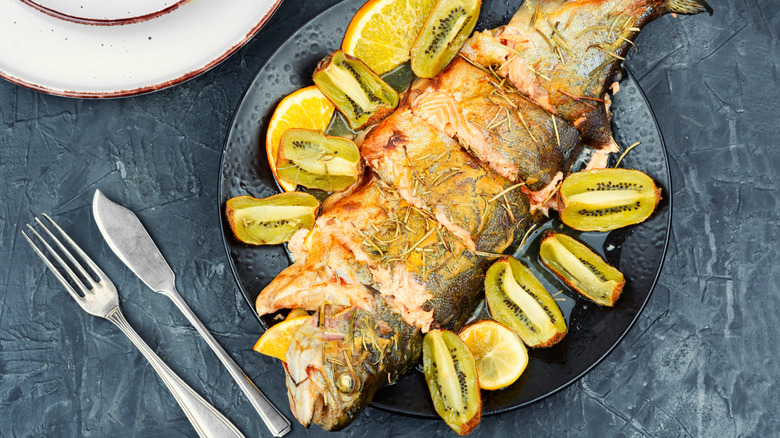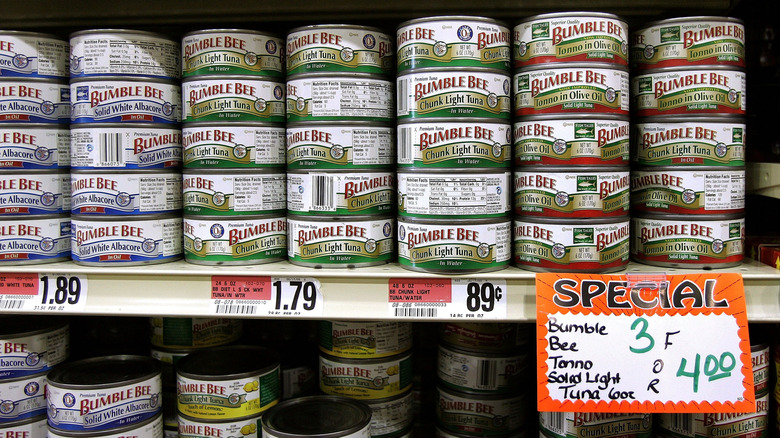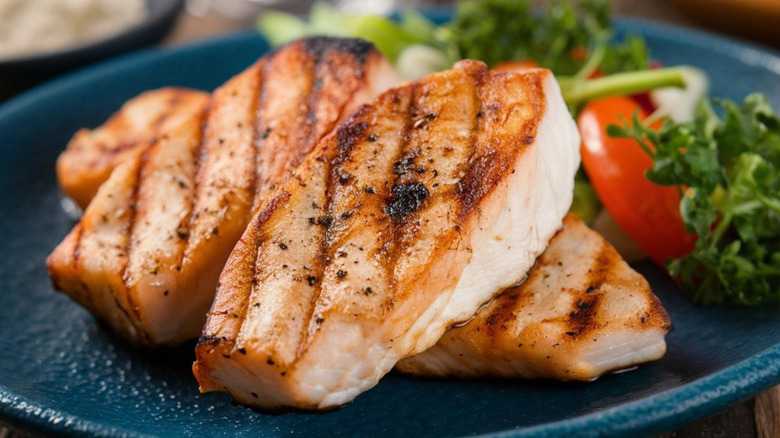Popular Fish With The Lowest And Highest Mercury Levels
No, Mercury isn't just that silver stuff in old-timey thermometers. Mercury is a naturally occuring element in the environment and can sometimes be found in your food — most notoriously in fish. Mercury is found in just about all seafood. While this isn't usually a big deal, mercury can prove potentially dangerous to vulnerable populations, such as children and those who are pregnant or breastfeeding (and the FDA does clarify that mercury can potentially have negative effects on anyone, under the right circumstances). Signs of too much mercury consumption include psychological issues, muscle weakness or numbness, difficulty with the senses, and balance issues.
As such, some government agencies recommend eating no more than five ounces per week of seafood that's considered high in mercury. If you eat seafood on a regular basis, what fish should you look out for? These are the popular fish with the lowest and highest mercury levels.
Lowest: Anchovies
Out of all the fish you could eat, anchovies show some of the lowest levels of mercury. This is in part because lower mercury levels are found in smaller fish or that don't eat a lot of other fish (compared to a lot of fish on this list, anchovies are pretty far down on the food chain).
Beyond being low in mercury, anchovies come with a lot of health benefits. They're a good source of omega-3 fatty acids, selenium, niacin, vitamin B12, vitamin A, calcium, and potassium. Really, the only thing that you need to watch out for with anchovies is the sodium content. Sometimes, when you get anchovies that come in a can, they can be on the high side; such is the case with options like King Oscar's anchovy fillets in olive oil, which, per serving, come with nearly 40% of your daily recommended sodium intake.
Lowest: Atlantic mackerel
When you pick up a can of mackerel, chances are that it's Atlantic mackerel, even though there are various different types of mackerel swimming around the ocean. Atlantic mackerel has some of the lowest levels of mercury out of your seafood options and, as such, is one of the healthier fish you could eat. It also contains plenty of protein and omega-3 fatty acids, and other nutrients such as selenium and vitamin D. It's safe to eat mackerel two or three times per week.
Similar in flavor to tuna, mackerel can be used in many of the same ways, such as in salads or sandwiches. You can also make fish patties from canned mackerel, pan-frying them like you might a crab cake. Just note that some canned mackerel can be high in sodium and cholesterol,. Bumble Bee's canned chub mackerel, for examples, contains 14% of your daily recommended sodium per serving and 25% of your daily recommended cholesterol per serving.
Lowest: Catfish
While catfish has gained popularity in the South as a delicious fish to enjoy fried, it doesn't boast the same popularity in other parts of the United States. However, if you're looking for a healthy fish that doesn't contain a lot of mercury, catfish needs to be on your radar.
In addition to being low in mercury, catfish also will give you more than your daily recommended amount of vitamin B12, as well as a nice amount of healthy fats, selenium, phosphorous, and potassium. Do note, though, that catfish's nutrient profile may differ according to how the fish was raised. Most commercially available catfish is raised on a fish farm, which comes with its own downsides, including the fish being fed abnormal diets and the farming having a negative environmental impact. However, catfish raised on a fish farm may offer more nutritional value. You'll need to weigh the pros and cons and decide what type of catfish you'd like to incorporate into your diet.
Lowest: Cod
Cod is a popular fish for good reason. Cod is flaky, easy to cook, and most popularly found in dishes such as fish and chips. It also has a mild flavor, so it's preferable to those who avoid seafood that tastes too "fishy."
Cod is also low in mercury and comes with a bevy of other health benefits. Cod is high in protein, omega-3 fatty acids, B vitamins, vitamin E, vitamin A, and vitamin C. Like many other popular fish varieties, cod is both caught wild and raised on a fish farm to meet demand. While concerns exist about fish farming's environmental impact and impact on fish nutrition, where you get your cod can play a role in its sustainability and healthfullness. For example, Norway is a large producer of farmed cod, and the Norwegian Seafood Council boasts that the country's farmed cod has a low carbon footprint compared to other meats, like beef.
Lowest: Haddock
Haddock is in the same family as cod, so the two are quite similar, including when it comes to their low mercury levels. However, when comparing these two fish, you'll notice some slight differences, such as the fact that haddock has a slightly fishier flavor profile. There are also some small textural differences that make haddock better for frying than, say, grilling.
In addition to having a low mercury content, haddock is also high in omega-3 fatty acids, phosphorous, B vitamins, and selenium. It's low in calories and fat. Haddock is only found in the Atlantic Ocean, and some experts recommend buying haddock caught in the U.S. Georges Bank or the U.S. Gulf of Maine, areas where fish populations are healthiest. It's worth noting that haddock is one of the most common fish to trigger fish allergies, and fish allergies can first appear in both childhood and adulthood.
Lowest: Herring
Often enjoyed similarly to sardines or anchovies, herring might not be as popular in the United States as it is in some parts of Europe. There, herrings are also known as kippers after they've been smoked. However, as one of the lowest-mercury fish out there, herring is worth adding to your pantry. It also provides health benefits, such as omega-3 fatty acids, selenium, iron, protein, and vitamin D.
Herring is often pickled, though it can be enjoyed fresh or smoked. If you choose to eat pickled herring, just look out for the sodium and sugar. For example, Vita Food's herring in wine sauce comes with 18% of your daily recommended sodium per serving. Pickled herring is often enjoyed as an appetizer but can also be added to toast and salad. Due to herring's similarity to sardines, it's sometimes included in cans of sardines with no one being any wiser.
Lowest: Pollock
While you might not exactly be picking up fresh pollock in the grocery store, you've probably purchased pollock if you've ever purchased frozen fish, whether in square or stick form. Those Gorton's battered fish fillets in your freezer? Yeah, that's pollock.
Luckily, pollock is one of the lowest-mercury fish options out there. However, while most pollock across the board is healthful, you'll want to take care with which pollock you choose if you're specifically looking for a sustainable option. Caught on both sides of the country, in the Atlantic Ocean and off the coast of Alaska, Alaska pollock is your more sustainable option, though you can find sustainable options caught specifically in Canada or in the U.S. Georges Bank and U.S. Gulf of Maine. Beyond where it was caught, it's worth also looking into how exactly that pollock was caught, as certain fishing methods can harm other species.
Lowest: Salmon
Great news, everyone — salmon, a favorite on restaurant menus and among the health-conscious, is a low-mercury fish. That said, not all salmon is the same. You have a lot of options at the grocery store.
For one, there's wild salmon and farmed salmon (farmed salmon is largely Atlantic salmon, one of several species). Wild-caught salmon is typically preferred for sustainability, though some farmed salmon from certain countries is still ranked as sustainable by reputable organizations like Seafood Watch. However, when you're looking at mercury levels, some wild-caught salmon actually contains higher levels of mercury than farmed salmon (National Library of Medicine). Some wild-caught salmon also contains more pollutants than farmed salmon, such as those from pesticides and chemicals. As such, you'll need to examine your options and make your own decisions regarding which type of salmon is best for your health goals as well as your sustainability preferences.
Lowest: Sardines
Like their similarly small friends, anchovies, sardines are likewise a low-mercury fish. Don't sleep on sardines. These fish offer not only a bevy of health benefits but also a great versatility that makes them an excellent addition to your pantry. Sardines provide omega-3 fatty acids, calcium, vitamin D, protein, and more. They can also be used in a variety of recipes, from salads to pasta sauces and pizza, or just enjoyed on their own.
However, be careful as to where you source your sardines. Some studies have found that sardines in certain areas of the world contain contaminants beyond mercury, such as cadmium, lead, and other toxic metals. Additionally, depending on the brand of sardines you purchase, you may find that they're canned with a large amount of salt and contain high levels of sodium. Sardines are also high in purines, which can cause gout or kidney stones.
Lowest: Sole
Unlike the small sardines or anchovies, sole is a flat fish, which is exactly what it sounds like. It's also a low-mercury fish, and one that's long been a favorite. This is particularly so in fine dining, and its price tag often reflects that. Sole has been enjoyed by decadent diners for centuries.
Like salmon, sole and its benefits differ depending on where it's caught. Some may know sole as "Dover sole," but Dover sole is not really caught in Dover. Instead, you can find this fish captured anywhere from Alaska to the Atlantic and the Mediterranean. Many experts recommend purchasing Alaskan sole in particular as a sustainable and nutritious variety, offering protein, omega-3 fatty acids, vitamin D, selenium, and vitamin B12. When you buy sole, though, just make sure you're actually getting the real deal. Sometimes, unscrupulous sellers will swap sole out with the more affordable arrowtooth flounder.
Lowest: Tilapia
Tilapia is a low-mercury fish that comes with the benefits of being budget-friendly and easy to cook, as well as health benefits such as protein, phosphorus, vitamin D, selenium, choline, vitamin B12, and niacin.
That said, tilapia also has a lot of controversy surrounding it, so you may want to avoid this fish if you can't be 100% certain where it comes from. Tilapia farming can introduce a range of nasty ingredients into the fish — such as antibiotics and even animal waste — that make their way onto your plate. This is primarily a concern with tilapia farmed in China. Unfortunately, it's not uncommon to find China-farmed tilapia in the freezer aisle. Before buying frozen tilapia, double-check the tilapia's origins for the healthiest fish possible. Safe tilapia sources include the United States, Canada, Ecuador, Peru, and the Netherlands. Commercially available tilapia is largely farmed, so there's little need to search for wild-caught tilapia.
Lowest: Trout
A low-mercury fish, rainbow trout is also a good source of protein, omega-3 fatty acids, and vitamin D. However, trout is frequently caught by recreational fishers, and that recreationally caught trout may not be as healthful as trout you purchase in the grocery store.
As an example, some experts warn against eating trout caught within New York's Adirondack Park at all if you're within a high-risk group, as the area's lake trout is considered higher in mercury than your average rainbow trout that you might purchase elsewhere. Likewise, studies have found that wild rainbow trout in Chile may contain high levels of heavy metals, particularly in areas exposed to agricultural operations. In general, experts recommend against consuming any rainbow trout from Chile, as it poses a high environmental risk. In contrast, farmed rainbow trout are considered safe to eat even for high-risk groups, such as pregnant individuals and children.
Lowest: Whitefish
You may hear the term whitefish used to describe any flaky, white fish that's in mass-produced fish products, such as fish sticks. But, whitefish is actually its own thing. A freshwater fish that inhabits northern lakes in the United States, whitefish is high in fat, mild in flavor, and easy to cook — the higher fat content makes it more difficult to overcook. It”s also low in mercury.
If you want real, authentic whitefish, you may have the best luck looking to Jewish cuisine, which uses the specific species known as Lake Whitefish, found in the Great Lakes, for dishes such as gefilte fish. This fish is sometimes smoked and dried, but it also can be used to create a salad with mayonnaise, sour cream, celery, and herbs for topping bagels. You can also use whitefish just about anywhere you might another fish thanks to its mild flavor and flaky, firm texture.
Lowest: Light canned tuna
If you're specifically looking for a canned fish that's easy to use, affordable, and familiar, you're probably going to reach for canned tuna. However, be careful with the canned tuna you choose. Some varieties and brands contain more mercury than others. Light canned tuna is the option for the lowest mercury levels possible.
Light tuna has about 20 micrograms of mercury per every 5 ounces. Compare that to canned albacore or yellowfin tuna, which can have more than double the amount of mercury. Atlantic bluefin tuna can even have more than 10 times that amount of mercury. This is all due to the size of the tuna when it's caught. Smaller fish contain less mercury, and some members of the tuna family can grow quite large. Atlantic bluefin tuna are the largest types of tuna, growing up to 15 feet in length and up to 1,500 pounds.
Highest: Fresh tuna
As we mentioned, not all tuna is safe to eat if you're trying to avoid high levels of mercury. Fresh tuna in particular has a high level of mercury and should be avoided accordingly. Bigeye tuna is one of the worst offenders, as are fresh and frozen albacore tuna and yellowfin tuna. Some types of tuna may contain so much mercury in a single serving that they exceed your weekly recommended mercury intake.
You don't need to avoid tuna altogether, though. Canned tuna contains overall less mercury than most varieties of fresh tuna. The one exception is fresh skipjack tuna, which contains less mercury than canned albacore tuna. Overall, if you want to eat tuna, opt for canned light tuna, which has the lowest mercury levels of all. Better yet, choose a fish variety that's low in mercury across the board, such as salmon, anchovies, or sardines.
Highest: King mackerel
The bigger the fish, the more mercury in the fish. As such, larger varieties of fish that would normally be considered safe to eat in terms of mercury levels can become fish that you want to limit. This is the case with mackerel. While Atlantic mackerel may be considered a low-mercury fish, the king mackerel is high in mercury due to sheer size. Known as a large, aggressive fish, king mackerels live in the Atlantic but are significantly bigger than their siblings, growing up to 100 pounds and more than 5 feet.
The FDA recommends not eating king mackerel at all if you're pregnant, may become pregnant, are nursing, or if you're a young child. Why should you not eat the fish if there's even a chance of becoming pregnant? The FDA clarifies that doing so can cause mercury to accumulate in your blood stream, and it can take more than a year for that mercury to dissipate.
Highest: Marlin
Marlin are a popular game fish hunted down by recreational fishers. But, you should think twice about eating any marlin that you or someone else catches, or even if you find marlin on a fine-dining restaurant's menu accompanied by a hefty price tag (it's particularly popular in Hawaii, Japan, and Mexico). While sometimes eaten in steak form or raw as part of sushi or sashimi, marlin isn't safe for everyone.
While marlin does come with certain health benefits, such as high levels of B vitamins, selenium, calcium, and protein, it also contains a very high level of mercury, making it one of the handful of fish that the FDA recommend those in at-risk populations avoid altogether. Marlin are large fish and they eat a lot of other fish, so they accumulate a lot of mercury in their bodies over time. The bigger and older the fish, the more mercury exists.
Highest: Swordfish
Swordfish is another fish that shows up on fine dining menus on occasion. It's often prized for its flavor and texture, both of which make the fish stand apart from other seafood, as it's not really flaky and also not really fishy. Instead, it has a firmer texture and a milder flavor.
Despite the fact that some love swordfish, it's not a great, healthful choice for some. Swordfish contains a high amount of mercury due to the fish's large size and predatory nature. Swordfish can grow up to 15 feet long and 1,400 pounds. That said, some may find that the high mercury content isn't worth worrying about when you consider swordfish's benefits. Beyond the texture and flavor that some may prefer, swordfish is also a good source of protein, niacin, B vitamins, phosphorous, selenium, and omega-3 fatty acids. Swordfish can be prepared much like a steak, grilled or sauteed.
